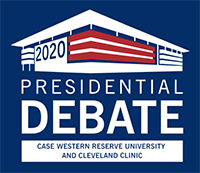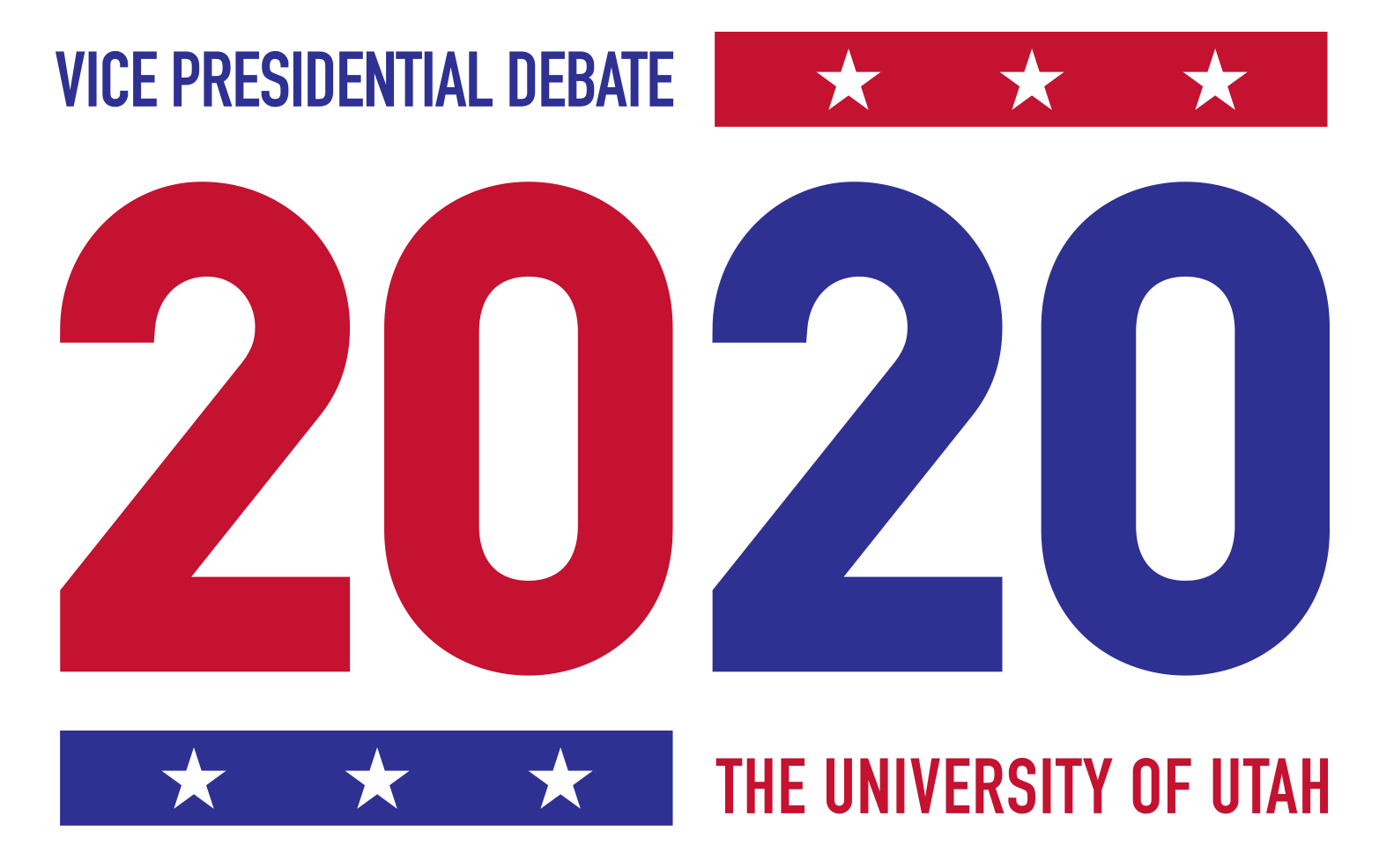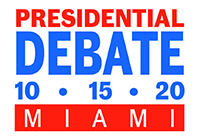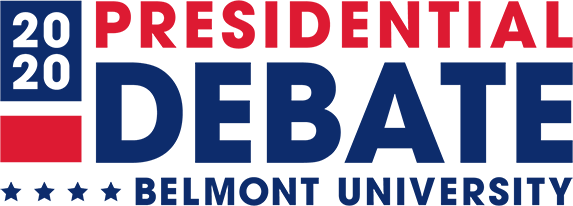The televised presidential debates are the mega-events of
the fall campaign. Stakes are high as the candidates
face each other, across a single stage, within a month of
the election, before a television audience of tens of
millions of people. A debate can reveal the
candidates' differences and ability to think on their feet
or it can devolve into a scripted exercise bordering on a
joint press conference or an exchange of soundbites.
Mega-Events
 , , |
First
Presidential Debate |
Tues.
Sept. 29, 2020 |
Health
Education Campus (HEC), Cleveland, OH |
 |
Vice
Presidential Debate |
Wed, Oct. 7, 2020 |
The University of Utah,
Salt Lake City, UT |
 |
|||
 |
Third Presidential
Debate |
Thurs. Oct. 22, 2020 |
Belmont
University, Nashville, TN |
changes due to the pandemic
The fall presidential and vice presidential debates are high stakes spectacles which tend to produce a few memorable moments rather than a reasoned discussion of the issues; indeed some have criticized the events as exchanges of talking points. They draw large audiences of television viewers; the record was set by the first presidential debate between Clinton and Trump at Hofstra University on Sept. 26, 2016, which drew an estimated audience of 84.0 million viewers according to Nielsen. By comparison, the first debate between Trump and Biden on Sept. 29, 2020 drew an estimated television audience of 73.1 million viewers.
The debates have been organized by the
non-profit Commission on Presidential Debates (CPD) since
1988. Although other organizations have put forth
proposals for debates, none have come to fruition. In
recent cycles, the CPD has organized three presidential
debates and one vice presidential debate held in the closing
weeks of the campaign between late September and
mid-October. (The earliest and latest presidential
debates were LWV-organized debates on Sept. 21 and Oct. 28,
both in 1980, when there was a lot of wrangling over the
participation of independent candidate John Anderson).
With the exception of 1992, when Ross Perot made the cut,
the debates have featured just the two major party nominees,
as other candidates have failed to meet an arbitrary polling
threshold set by the CPD.
On Oct. 11, 2019, the CPD announced dates,
sites and candidate selection criteria for the planned 2020
debates (+).
The
pandemic significantly impacted debate planning. Two
of initial sites, the University of Michigan and the
University of Notre Dame, pulled out of hosting debates,
after which the CPD announced backup sites (+).
There was talk that the debates could or should be held in
TV studios without audiences. Cleveland Clinic served
as health security advisor to the CPD, and many changes were
made, including strict COVID-19 testing, very small
in-person audiences, no spin rooms and plexiglass at the
vice presidential debate.
The Trump campaign made a push for four
presidential debates, one more than usual, including one
earlier in September on account of increasing numbers of
early voters (+),
but the CPD and the Biden campaign stayed on three. In
the end there will be only two debates; President Trump's
bout with COVID-19 resulted in plans for a virtual format
for the second presidential debate, which Trump
declined. Instead, on the evening of Oct. 15, the
candidates held dueling town halls, Biden on ABC News and
Trump on NBC News.
The Commission on Presidential Debates
This was the ninth election cycle for which
the CPD oversaw the 2020 general election debates.
Before formation of the CPD, debates were sponsored by the
League of Women Voters (1976, 1980, and 1984) and the
networks (1960). The CPD develops the candidate
selection criteria which are used to evaluate which
candidates it will invite to participate. It
proposes dates and locations of debates. It lines up
corporate sponsors and oversees preparations for these
important events. CPD debates are typically held in
university venues before live audiences; hosting a debate
can bring a lot of exposure to institution, but it also
imposes significant demands. In 2007, 19 sites
submitted applications to host one of the debates, but
only six sites applied to host one of the 2020
debates.
| 2003 |
2007 |
2011 |
2015 |
2019 |
|
| CPD posts site
selection criteria |
Jan. 6, 2003 |
Jan. 2, 2007 |
Jan. 3, 2011 |
Jan. 2, 2015 (+) |
Jan. 2, 2019 (+) |
| Deadline to submit
proposal to host debate (Number of Applicants) |
March 31 (14) |
March 31 (19) |
March 31 (12) |
March 31 (16) |
April 2 (6) |
| CPD review of proposals and site surveys | ... |
... |
... |
... |
... |
| CPD announces
criteria (for 2004, 2016) |
Sept. 24 |
... | ... | Oct.
29 |
|
| CPD announces proposed
sites, dates, criteria |
Nov. 6 |
Nov.
19 |
Oct.
31 |
Sept.
23 |
Oct.
11 |
| 2004 |
2008 |
2012 |
2016 |
2020 |
|
| CPD announces formats |
June 17 |
July
25 |
July
7 |
June 23 |
|
| CPD announces
moderators |
Aug. 13 |
Aug. 5 |
Aug. 13(+) | Sept.
2 |
Sept.
2 |
| Campaigns negotiate |
... |
... |
... |
... | ... |
| Campaigns reach
agreement/MOU |
Sept.
20 |
Aug.
21 |
Oct. 3 (+) |
||
| Final
formats/moderators |
Sept.
25 |
||||
| First debate |
Sept. 30, 2004 |
Sept. 26, 2008 |
Oct. 3, 2012 |
Sept. 26, 2016 |
Sept. 29, 2020 |
See CPD press releases.
Critics charge that the CPD is a bipartisan rather than a nonpartisan organization, and can scarcely be expected to be fair to third party and independent candidates. The CPD is headed by co-chairs Frank J. Fahrenkopf, Jr., a former RNC chairman, Dorothy Ridings, a former president of the LWV (from Jan. 2017) and Kenneth Wollack, a former president of the National Democratic Institute (from Oct. 2019) as well as a board of directors. Critics also question the CPD's reliance on corporate money and maintain that it lacks transparency.
The core question boils down to who is on the debate stage. Clearly some limits must be set, for with too many candidates these events will become unmanageable. Starting in 2000, the CPD has used three simple criteria. (In earlier cycles, the CPD used a complicated set of "objective criteria" that drew much criticism). To participate in the debates, candidates must:
(a) be constitutionally eligible;
(b) have ballot access in enough states to win a majority of electoral votes (at least 270); and
(c) have a level of national support of at least 15 % as measured in polls done by five selected national polling organizations (+).
Third party candidates have raised strong objections to
their exclusion from the debates. They argue that the
15-percent threshold is arbitrary and too high. In
2016 the Libertarian candidate Gary Johnson seemed like he
might have a shot at meeting the 15-percent but fell well
short (+).
In 2020 the third party candidates and their supporters
tried again, but none of them came close to qualifying (+).
There have been many legal challenges to the CPD and its
criteria over the years, all unsuccessful. Legislation
has been been introduced in Congress but made no
headway. [See:
Efforts
to Open the Debates]
Excluded candidates and their supporters are left with
generally ineffectual protests. These candidates
sometimes do interviews from the debate site, their
supporters can protest outside the security perimeter, and
they may live tweet or otherwise respond during the
event. In 2012 Occupy the Debates sought to encourage
an alternative conversation and activities (+).
However, nothing can make up for a candidate's exclusion
from the debate stage.
Each cycle the CPD tweaks its formats to try
to improve the debates. For 2016 the report of the Annenberg
Working Group on Presidential Campaign Debate Reform,
released June 17, 2015, offered a number of recommendations
"to improve the quality, reach and relevance of
debates." This was a very significant report, with
recommendations in three areas: expanding and enriching
debate content; broadening the accessibility of the debates;
and improving the transparency and accountability of the
debate process. One of the most noteworthy proposals
was to "eliminate on-site audiences for debates other than
the town hall, and, in the process, reduce the need for
major financial sponsors and audiences filled with
donors." This was a direct challenge to the way the
CPD has done business, and was not implemented. The
idea of holding debates in studio without a live audience,
possibly sponsored by news organizations, would not only
reduce costs but would also diminish some of the spectacle
of these events, which might be a good thing.
Instead of big changes, the CPD has made a number of minor adjustments. For the 2008 debates CPD loosened time constraints (+). For the 2012 debates, seeking to focus more time on big issues, the CPD tried a new format in which the first and last debates were divided into six approximately 15-minute long segments or pods (+). Even critic George Farah of Open Debates stated that, "The Commission deserves praise for responding to its critics and advocating for more informative debate formats." However, he went on to outline "major problems" with the CPD debates (+).
The format of a debate has a critical impact on nature of the exchanges that occur or do not occur and on the amount of information viewers are able to learn. The most obvious parameter to consider is who is on the stage and who is not, but there are many other factors. Is there a live audience and are they controlled or disruptive? Is the subject matter confined to one area, such as the economy, or is it more wide-ranging? What is the time limit on candidate responses and on rebuttals? Finally, who asks the questions? The 1960 and 1976-1988 presidential debates exclusively used the panel of reporters. More recently the single moderator and town hall formats have come into favor. The town hall format was first used in the Richmond, VA debate in 1992. Having an audience of undecided voters pose the questions likely results in a broader range of questions, but on the downside this format does not foster follow-ups. One format which has not been attempted is to have the candidates question each other directly. The Annenberg report recommended increasing direct candidate exchanges, as well as using "alternate formats for some of the debates, including a chess clock model that gives each candidate an equal amount of time to draw upon."
Former House Speaker Newt Gingrich has challenged the substantiveness of the CPD-sponsored debates. In an appearance in Des Moines, Iowa on Aug. 12, 2005 he called for an end to the current tightly formated presidential debates saying they "trivialize the whole process." Instead, Gingrich said, the candidates should engage in a straightforward dialogue without a moderator for 90 minutes. During a "Lincoln at Cooper Union" dialogue held on Feb. 28, 2007, Gingrich stated "I propose that we challenge every candidate in both parties to make a commitment before the nominating process begins that if they become the nominee they will agree from Labor Day to the election to nine 90 minute dialogues, one a week for nine weeks..."
"I commend to you the 1996, 2000 and 2004 presidential
debate agreements which run 53 pages apiece. They
are bizarre examples of lunacy. No serious adult
should agree to them. They're childish. You
don't elect a president to memorize. You elect a
president to have wisdom, to have serious thought, to
reflect." —Newt Gingrich
Another critic, Ralph Nader, has argued that 21 presidential debates should be held, organized by communities around the country.
"Instead of the present, stifling, programmed three
debates by the CPD, these twenty one debates would throw
aside many of the taboos, bring the people into the
process, address regional needs, excite larger voter
turnout and compel the candidates to be better, more
forthright candidates," —Ralph
Nader (+).
While it is nice to contemplate the idea of a series of
dialogues or thoughtful discussions of issues, such debates
are unlikely to ever occur because the candidates and their
campaigns have the final word and the risk of participating
in a free-ranging series of events in the closing months of
the campaign is too great.
There is no requirement that presidential candidates participate in debates, but it would be quite damaging to be seen as avoiding or blocking the debates. When it comes to the number, timing and formats of the debates, as well as who will participate, there is a lot of discussion, but invariably the major party candidates and their campaigns have the final word. The CPD proposal is on the table and serves as a starting point, but each campaign acts in its own best interest. The goal is to create the most favorable possible set of circumstances for their candidate. (The memoranda of understanding from two of the debates that have come to light show the minute details involved: 2004 [PDF] and via Time magazine's Mark Halperin 2012).
As noted above, the Trump campaign has been
seeking four rather than three presidential debates and a
debate earlier in September in response to early voting.
In past cycles, there had been ritual debates
over the debates. For several weeks the two major
campaigns jockeyed back and forth haggling over details big
and small—everything from the number and format of the
debates to the podium height and shape and who is or is not
acceptable as a moderator. Closed-doors meetings
alternated with pointed public pronouncements, but
eventually the two sides reached an accord.
However, in recent cycles the debate
negiotiations have occurred quietly and without
fanfare. In 2008 the Obama and McCain campaigns
reached an agreement quickly and without posturing. In
2012 the campaigns again carried out their negotiations out
of the spotlight (+).
The
same
occurred
in
2016;
Marc
Elias
for
Clinton
and
Dan McGahn for Trump headed negotiations that made no news.
In the lead up to the debates, the candidates
undergo intensive preparations. Briefing books are put
together, and the candidates engage in mock debates.
Media accounts sometimes provide glimpses of these
rehearsals. In 2016 there was a marked contrast
between the two candidates' approaches, as Clinton made
intensive preparations, including staying off the campaign
trail for days in advance of the encounters, while Trump did
much less prep and continued to hold rallies. There
are also efforts
to set expectations. In the background, the
campaigns' and the parties' rapid response efforts ramp up
and issue various communications to set the stage as well as
prebuttals rebutting points that they expect to be
made. Closer to the debate, the candidates may be seen
engaging in public displays of confidence such as throwing a
baseball, jogging, or giving a thumbs up.
During the debate, citizens watching on
television or the Internet form impressions of the
candidates based on their claims, assertions, gaffes or
awkward moments and body language. (People who listen
on the radio may form very different impressions). An
ongoing and vibrant discussion unfolds in the social media,
as Tweets, Facebook postings and the like amplify key
moments. Not all the claims and assertions are
true. The social media and traditional media will
bring misstatements to the fore, but some have argued that a
fact checking role should be integrated into the debates as
they proceed. In addition to its work organizing the
debates, the CPD has also undertaken efforts to enhance the
viewing experience. Starting in 1996, the CPD ran a
Debate Watch program (>)
to encourage debate-watching groups around the
country. For 2012 the CPD announced "The Voice Of..."
internet initiative (+).
The rapid response units go into high gear
during and after a debate, working feverishly to produce
rebuttals to various claims; these documents are e-mailed
out throughout the evening. Following each debate
occurs one of the most unique and fascinating scenes in
American politics. Top campaign staff, campaign
surrogates and party leaders gather in the media filing
center and spin reporters, telling them what they have just
seen. On opposite sides of the filing center chairs
are set up for Democratic and for Republican partisans to do
satellite interviews with local stations around the
country.
After the debate pundits and commentators
weigh in. Spin soundbites form an integral part of
post-debate coverage. Many media outlets assemble
groups of undecided voters to watch debates and then
interview participants for their reactions. The media
also fulfill their fact-checking role.
Several third party candidate debates typically occur but they usually receive virtually no attention. The Free and Equal Elections Foundation has done significant work organizing open debates, and has organized two general election debates this cycle. The threshhold for participating was candidates had to be on the ballot in eight states. Five candidates participated in the debate on Oct. 8, 2020 in Denver, CO: Brian Carroll (Am.Sol.), Brock Pierce (Indep.), Don Blankenship (Const.), Gloria La Riva (PSL) and Howie Hawkins (Grn.) (+). Another is scheduled for Oct. 24, 2020 in Cheyenne, WY (+).
In 2016 Free and Equal organized the People's Presidential Debate, a two-hour forum at University of Colorado Boulder's Macky Auditorium on Oct. 25, 2016, but only three candidates participated: Darrell Castle (C), Rocky De La Fuente (I) and Gloria LaRiva (PSL). A more noteworthy forum brought Gary Johnson (L) and Jill Stein (G) together on The Tavis Smiley Show, taped live in Los Angeles on Oct. 31, 2016. Earlier Evan McMullin (I) sought without success to engage Johnson, but Johnson had been aiming for the big stage.
In 2012 there were several debates involving
the major third parties. Free and Equal organized two
debates. The first in Chicago on Oct. 23 brought
together Gary Johnson, Virgil Goode, Jill Stein and Rocky
Anderson (+);
Johnson
and Stein advanced to the second, in Washington, DC on Nov.
5 (+).
Additionally,
Ralph
Nader
hosted
a
third
party
candidate
debate
with
the
four candidates in Washington, DC on Nov. 4 (+).
| 2016 Clinton-Trump |
Sept.
26, 2016 Hempstead, NY |
Oct.
9, 2016 St. Louis, MO |
Oct.
19, 2016 Las Vegas, NV |
Kaine-Pence Oct. 4, 2016 Farmville, VA |
| 2012 Obama-Romney |
Oct.
3, 2012 Denver, CO |
Oct.
16, 2012 Hempstead, NY |
Oct.
22, 2012 Boca Raton, FL |
Biden-Ryan Oct. 11, 2012 Danville, KY |
| 2008 McCain-Obama |
Sept.
26, 2008 Oxford, MS |
Oct.
7, 2008 Nashville, TN |
Oct.
15,
2008 Hempstead, NY |
Palin-Biden Oct. 2, 2008 St. Louis, MO |
| 2004
Bush-Kerry |
Sept.
30,
2004 Coral Gables, FL |
Oct.
8, 2004 St. Louis, MO |
Oct. 13, 2004 Tempe, AZ |
Cheney-Edwards Oct. 5, 2004 Cleveland, OH |
| 2000
Gore-Bush |
Oct. 3, 2000 Boston, MA |
Oct. 11, 2000 Winston-Salem, NC |
Oct. 17, 2000 St. Louis, MO |
Lieberman-Cheney
Oct. 5, 2000 Danville, KY |
| 1996 Clinton-Dole |
Oct. 6, 1996 Hartford, CT |
Oct. 16, 1996 San Diego, CA |
. | Gore-Kemp
Oct. 9, 1996 St. Petersburg, FL |
| 1992
Bush-Clinton-Perot |
Oct. 11, 1992 St. Louis, MO |
Oct. 15, 1992 Richmond, VA |
Oct. 19, 1992
East Lansing, MI |
Quayle-Gore-Stockdale
Oct. 13, 1992 Atlanta, GA |
| 1988 Bush-Dukakis |
Sept. 25, 1988 Winston-Salem, NC |
Oct. 13, 1988 Los Angeles, CA |
. | Quayle-Bentsen
Oct. 5, 1988 Omaha, NE |
| 1984
Reagan-Mondale |
Oct. 7, 1984 Louisville, KY |
Oct. 21, 1984 Kansas City, MO |
. | Bush-Ferraro Oct. 11, 1984 Philadelphia, PA |
| 1980 Carter-Reagan-Anderson |
Reagan-Anderson
Sept. 21, 1980 Baltimore, MD |
Carter-Reagan
Oct. 28, 1980 Cleveland, OH |
. | none |
| 1976 Ford-Carter |
Sept. 23, 1976 Philadelphia, PA |
Oct. 6, 1976 San Francisco, CA |
Oct. 22, 1976 Williamsburg, VA |
Dole-Mondale
Oct. 15, 1976 Houston, TX |
| 1960
Nixon-Kennedy |
Sept. 26, 1960 | Oct. 7, 1960 | Oct. 13, 1960 | Oct. 21, 1960 |
Resources
2016 | 2012 | 2008 | 2004 | 2000
A large amount of
scholarly work has been done on presidential debates.
>
In June 2015 the Annenberg
Working Group on Presidential Campaign Debate Reform
released a 48-page report with recommendations "to
improve the quality, reach and relevance of debates."

